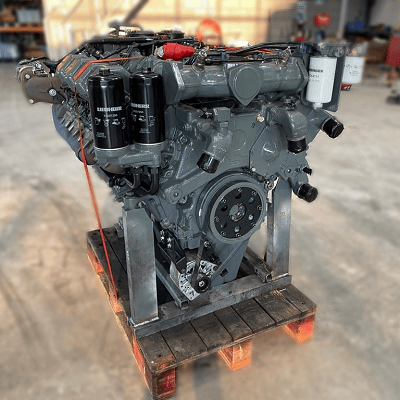The process of a dyno test on a Liebherr engine

When it comes to heavy machinery, reliability and power are paramount. Liebherr, a name synonymous with innovation and excellence in engineering, stands tall as a pioneer in the realm of heavy equipment and machinery. From towering cranes to robust excavators, Liebherr’s engineering prowess extends to the heart of these machines. We delve into the world of dyno testing a Liebherr engine, uncovering the meticulous process behind unleashing the raw power concealed within.
The foundation of excellence
Before we embark on the journey of dyno testing, it’s crucial to understand the foundation upon which Liebherr engines are built. With decades of engineering expertise and commitment to quality, Liebherr engines are crafted to withstand the most demanding environment and deliver unparalleled performance. Each component is meticulously designed and rigorously tested to ensure reliability, efficiency and longevity.
The process
1 Preparation: The engine undergoes meticulous preparation before being mounted onto the dynamo meter. This includes ensuring all connections are secure, fluids are filled to the appropriate levels, and sensors are properly calibrated.
2 Mounting: The engine is carefully mounted onto the dynamometer, a specialized device designed to simulate real-world operating conditions. Precision is paramount during this step to ensure accurate results.
3 Initial checks: Once mounted, a series of initial checks are conducted to verify proper alignment, connection integrity, and functionality of all engine systems.
4 Warm-up: The engine is started and allowed to warm up to operating temperature. This ensures consistent results and minimizes the risk of damage during testing.
5 Baseline testing: With the engine warmed up , baseline tests are conducted to establish initial performance metrics. This includes measuring power output, torque, fuel consumption, and emissions at various RPM levels.
6 Load testing: The engine is subjected to progressively increasing loads to simulate different operating conditions, such as idle, partial load and full load. This allows engineers to assess performance across the entire operating range and identify any potential issues or optimization.
7 Data analysis: Throughout the testing process, data is continuously collected and analyzed in real-time. Advanced instrumentation and software are used to monitor performance metrics and identify trends or anomalies.
8 Optimazation: Based on the data analysis, adjustments may be made to optimize engine performance. This could involve fine-tuning fuel injection timing, adjusting air-fuel ratios, or optimize turbocharger boost pressure.
9 Validation: Once testing is complete, the results are meticulously reviewed and validated against predetermined criteria and specifications. Any deviations or anomalies are thoroughly investigated to ensure accuracy and reliability.
10 Reporting: Finally, a comprehensive report is generated detailing the results of the dyno testing, including performance metrics, observations, and any recommendations for further optimization or refinement.
The outcome of dyno testing
Dyno testing a Liebherr engine is more than just a routine procedure – it’s a testament to the unwavering commitment to excellence that defines Liebherr’s engineering philosophy. By subjecting their engines to rigorous testing and analysis, Liebherr ensures that each engine delivers the uncompromising performance, reliability, and efficiency that customers expect.
In conclusion, dyno testing a Liebherr engine is not just about measuring power output. It’s about unlocking the true potential of these remarkable engines and ensuring they exceed expectations in the most challenging environments imaginable.
The CNC milling process is a digital manufacturing process that is implemented by computer numerically controlled (CNC) machines. This process is used to produce parts with complex shapes, and the manufacturing process involves multiple steps. The following are the detailed steps of the general CNC milling process:Design: First, you need to design a CAD model of the parts you want to produce. A CAD model is a three-dimensional image created using computer-aided design software that can describe the shape, size, and features of a part.Programming: Next, you need to convert the CAD model into G-code, which is a type of computer instruction that controls the movement and operation of the CNC machine. G Code can be written manually or generated automatically using CAM software.Prepare the machine: Before you start machining, you need to check and prepare the CNC machine. This includes checking the machine's coordinate system, setting tools and cutters, and setting parameters such as the machine's speed and feed speed.Processing: After the machine is ready, the processing can begin. The machining process usually consists of multiple steps, such as roughing, finishing and drilling. At each step, the CNC machine moves tools and workpieces according to instructions in the G code to achieve the desired cutting operation.Inspection: After processing, the parts need to be inspected to ensure that they meet the design requirements and specifications. Inspection can be carried out by using measuring instruments, templates and other testing tools.Polishing and surface treatment: Parts can be polished and surface treated if needed to improve their surface finish and corrosion resistance. This can be done through the use of abrasives, chemicals and other tools.In short, the CNC milling process is a high-precision, high-efficiency manufacturing process for the production of parts with complex shapes. Through the control of CAD model and G code, the precise control of machine motion can be realized, so as to achieve high-precision parts processing.




Cnc Milling Online,Cnc Milling Part,Cnc Metal Milling Machining,Cnc Milling Services
Shenzhen ganzoo prototype manufacture co.,ltd , https://www.gz-proto.com